Wales
Heading to Wales, we see a shift in the weather, it's a sunny day.
As we drive across the River Severn over the Large Second Severn bridge we enter Wales,
you don't pass through a customs station, you pass through a toll booth. Wales has the highest concentration of castles in the British Isles, our time there would be very castle focused.
After gathering maps and other Wales info from the helpful ladies at the Tourist Information in Chepstow, we crossed the street and enter Chepstow Castle. Chepstow Castle overlooks the River Wye, and is the oldest surviving stone fortification in Britain. It was built by William the Conqueror in 1067, and was the southernmost of a chain of castles built along the English-Welsh border.
Tintern Abbey, located 4 miles north of Chepstow on the River Wye, was founded in 1131.
The spectacular ruins are a result of the decline in attracting new recruits to the monastery brotherhood after the Black Plague in the 14th century. Ultimately it was caused by King Henry VIII's takeover of the churches in England. When the King gave the building to the Earl of Worcester, lead from the roof was sold, and the decay of the shell of the buildings began.
From Tintern Abbey, we drove north through the town of Monmouth to Raglan.
Raglan Castle, complete with it's moat and towers, was built in the 15th century and was the boyhood home of Henry Tudor, who later would become King Henry VII. The English Civil War in the 17th century brought about the castle’s ruin.
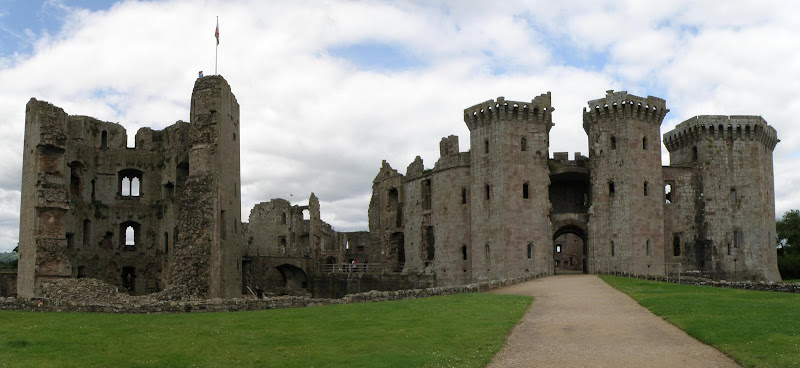
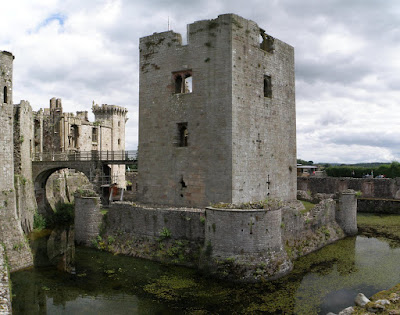
If the castle looks familiar to you, it's probably because the castle was used as a set for part of Led Zeppelin's 1976 release 'The Song Remains the Same'. Most of the exterior Napoleon sequences in Terry Gilliam's 1981 film 'Time Bandits' were also shot at Raglan Castle.
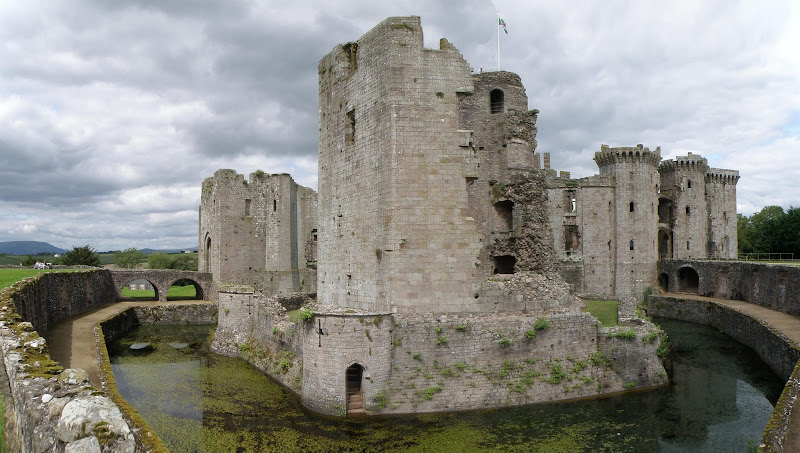
From the time we arrived at the castle to the time we left, this cute little cat snoozed on the grass. I am certain that a picture similar to this one is in a lot of tourists photo albums.
Driving back south towards the capital of Wales, we end up at Caerphilly Castle. We stop and pick up some sandwiches and drinks, and head into the castle to have a picnic on the grounds.
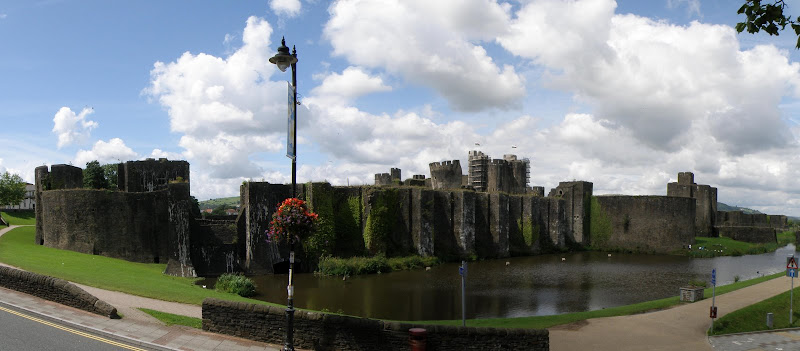
Caerphilly Castle is the largest castle in Wales and the second largest in Britain after Windsor Castle. Built mainly between 1268 and 1271, part of the construction involved building a mound across the Nant Gledwr that acted as a dam creating a large defensive lake south of the main castle. It is an early example of a concentric castle (a castle within a castle).

One of the most notable features of the castle, is its fractured and leaning south-east tower. The damage was inflicted by the Parliamentary army in 1648 during the Civil War.
Touring through the castle is made more nostalgic by the wedding celebrations and reception that are going on inside the grounds and great hall of the castle. The wedding party in their gowns and tuxedos, the guest in their suits and dresses, and us in our shorts and t-shirts.
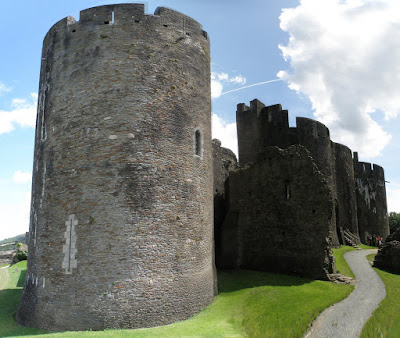
After becoming Wedding Crashers, we left the castle and crossed the street to the Tourist Info Centre where the even more helpful lady at the TI booked us a room in the town of Welshpool.
Cardiff
Cardiff is the capital and largest city in Wales. Archaeological evidence from sites in and around Cardiff shows that Neolithic people had settled in the area by at least around 4,000 BC, about 1500 years before either Stonehenge or The Egyptian Great Pyramid of Giza was completed.
Our first stop is the 11th century St. John the Baptists Church, the oldest church in the city of Cardiff. It doesn't make sense to us, but it is closed on a Sunday. So we head to Cardiff Castle.
Cardiff Castle is a medieval castle and Victorian architecture Gothic revival mansion, transformed from a Norman keep erected over a Roman fort... wow that's a mouthful. There may have been at least two previous Roman forts on the site, the first was probably built about 55 AD.
The Norman keep sitting on a motte (hill) was built in 1091 AD. The Castle, including the palace and clock tower, were refashioned in a gothic style both inside and out during the 19th century.
After touring through the amazingly crafted interior of the palace inside Cardiff Castle, we climbed the tower of the Norman keep for a view over the Castle and the city of Cardiff.
We left Cardiff to head towards North Wales, and after 2.5 hours of following horse trailers we arrived at the mid-point of Welshpool. Although Welshpool is still in Wales, Austin had us go back into England to get there, it wasn't any more exciting when coming back into Wales the 2nd time.
Welshpool
Finding the Farm house we were staying at was a challenge. Even though we punched the postal code into Austin, we ended up in the wrong part of town and had to ask a woman walking her dog to give us directions. Five minutes later we are heading up the gravel road to our huge farm house.

GPS units can be very handy for navigating your way to specific destinations. City Centres and Important locations such as TI offices can often be found built into the map systems
of most cities. The challenge in the British Isles is that most homes do not use a numbered
![]() address, usually only going by a building name and a street. Postal codes can narrow it
address, usually only going by a building name and a street. Postal codes can narrow it
down,
but GPS Longitude and Latitude is the most accurate way of finding your way.
As we are driving up to the B&B, we are stopped on the road by two cows, they just look at us and wouldn't get off the road. We revved the engine, beeped our horn, and finally had to yell at them to get them to move out of the way. This truly is a farm house with Horses, cows, and chickens.
It's a big beautiful house with great views over the valley, and it's only 35£ per person per night. When we tell our host about the cows, she laughs and tells us just to honk, they'll move.
It's only a 5 minute drive into town, where we picked up some take out Fish & Chips for dinner.
In the morning we are introduced to something new, an electric shower. It's got dials and knobs to turn the shower on and get hot water, but try as we might, we can't figure this damn thing out. Once we gave up and got dressed, I found this string hanging from the ceiling, when I pull the cord, the shower controls power light comes on... Doh! It's back to a full english breakfast today.
Before we leave we stop to see the Shetland pony, and he wanders over to the fence. Norine rubs his chin and is talking to him, that's when I notice he has become a 5 legged pony. When I tell Norine, the friendly moment is spoiled, and it's time to head off into a mix of cloud and sun.
On the edge of town is the 12th Century Powis Castle & Gardens, sadly it doesn't open until 1:00, and we aren't going to wait around, so a quick picture from and of the gate will have to do.
We pass some ruins on the hilltop at Llangollen. Castell Dinas Brân (Crow Castle) was built in 1260 by the Prince of Wales. In 1276 war started between England and Wales, and by 1282 after the death of the Prince and his 4 sons, the castle was left in ruins. The first building at Dinas Brân was not the castle which now stands in ruins, but an Iron Age hillfort built around 600 BC.
We are buzzed by 3 fighter jets as we enter the Snowdonia National Park on our way into the cute village of Betws-y-Coed (pronounced Bettoos uh coyd). Betws-y-Coed (Prayer house in the wood) sits in a valley near the point where the River Conwy is joined by the River Llugwy and the River Lledr, and was founded around a monastery in the late sixth century. We didn't see any Ferret's.
In the center of the village is the scenic Pont-y-Pair bridge (the bridge of the cauldron) built in 1468 over the River Llugwy, and the very popular 53 hole rock canyon and falls. There is people everywhere on the rocks around the falls.
Betws-y-Coed is famous for it's cuisine, especially Welsh rarebit - a dish consisting of cheese sauce with a mustard tang poured over buttered toast, we'll pass. Of course this village also has a St Mary's Church. Just outside of town we stop at the lovely
Swallow Falls before leaving.
Traveling through Snowdonia National Park to Conwy, is done via a lot of small roads, including Llanrwst's Pont Fawr bridge over the River Conwy. Originally built in 1636 to carry horses and carts, it follows the rule of first to the peak, and we had to back up and let others go before we could finally cross it. The Vine covered tea house in Llanrwst is also very unique, originally called "Tu Hwnt i'r Bont" it was a 15th-century Court House, and is now part of the National Trust.
Conwy
When we arrived in Conwy, our first destination is the TI, where we booked a room. and wandered Conwy castle in the drizzle. The Castle and the town walls were built on the instructions of Edward I between 1283 and 1289, as part of his conquest of Wales.
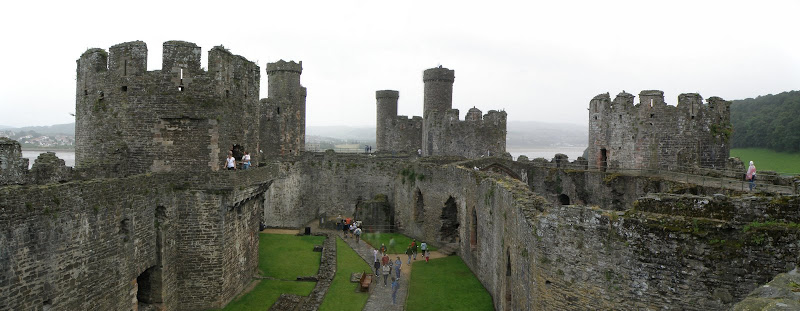
Conwy Suspension Bridge, was one of the first road suspension bridges in the world. Today it is a foot bridge, nestled between a modern vehicle bridge and enclosed 19th century train bridge.
There is a number of historic houses in Conwy, including Aberconwy House, believed to be the oldest town house in Wales dating from the 14th-century. The historic merchant's house has been carefully restored to reflect the daily life of its residents over time.
Plas Mawr Elizabethan townhouses dating from the 16th century,are closed 1 day a week... today. It is thought to be the best-preserved Elizabethan town house in the United Kingdom.
Of course Conwy has a St. Mary's church too... but it's closed too. Not being able to see inside the 12th century church, we wander the outside, markers dating back to 1805, and a grave marked "we are seven", the grave of 7 brothers and sisters, sad. We left the centre of town and walked the walls of the city, considered by some to be the best Medieval walls in Britain.
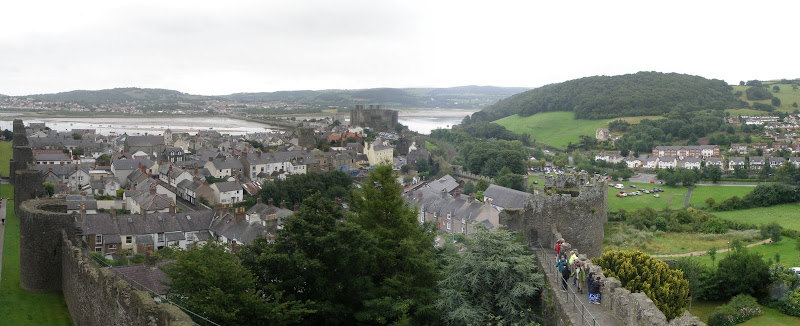
From the walls we wander down to the quay area of Conwy and check out the smallest house in Britain (72 inches wide, 122 inches tall). The house was lived in from the 1500's until 1900, when the owner was a 6ft 3 inch fisherman named Robert Jones. The rooms were too small for him to stand up in fully and he was eventually forced to move out when the council declared the house unfit for human habitation. The house is still owned by his descendants.
After walking the entire town of Conwy, we went to our B&B just outside of the town walls. Whinward House is an 1890's Coach House, a very nice place, with even nicer hosts, and is conveniently located between the town and the marina. Chris and Jan told us of the Mount Conwy hike, the trail is just a short walk from our B&B... seems like a good idea since it stopped raining.
The Mount Conwy hike has amazing views, I keep stopping to look back on the town and Conwy Castle. At the summit is Neolithic Hut Circles and an Iron Age hillfort called Castell Caer Seion (1200–800 BC). Castell Caer Seion has 24 hut circles inside, and some outside its walls.
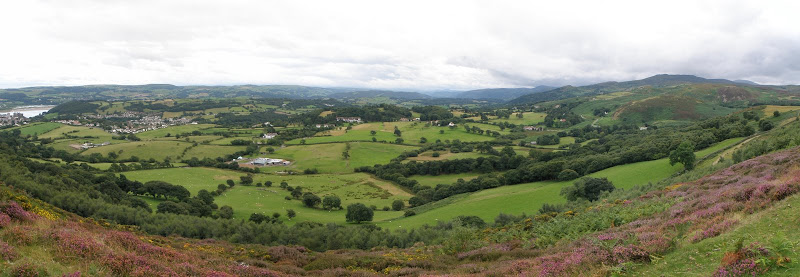
It's a beautiful hike, with colourful heather, lavender and wildflowers, sheep wander all around us, and the views change as we get further from the town. Amazing views across the countryside in one direction and steep overlooks of beaches and golf courses in the other direction.

The whole time we were hiking we somehow kept ahead of the rain, and then walked back down the mountain to the marina... it started pouring while we ate dinner at 'Mulberry's on the Marina'.
After dinner the rain stopped just long enough for us to walk back to our B&B.
Welsh Castle Day Trip
The other guest in our B&B is a hotel inspector, he's a real prude and we struggle to keep him talking at breakfast. He tells us about the Royal Air Force nearby, and how Prince William is there. "He better go through the military if he's going to lead our country one day"... uh-huh, the Royal family leads the country. He was unhappy that they wrapped the toast in a napkin to keep it warm, "it makes the bread soggy", and he thought the jams, ketchup and sauces should be in glass bowls instead of their original containers. That's all he could find wrong with the place... good for them!
Even though our hosts Jan and Chris thought trying to see five castles in one day was too much, we decided to spend the day doing the Welsh Castle run, the five major castles of King Edward.
Beaumaris Castle was the last of the fortresses built as part of King Edward I's campaign to conquer the north of Wales. It was begun in 1295 and construction continued for 35 years, but wasn't completed because King Edward I turned his attentions towards Scotland.
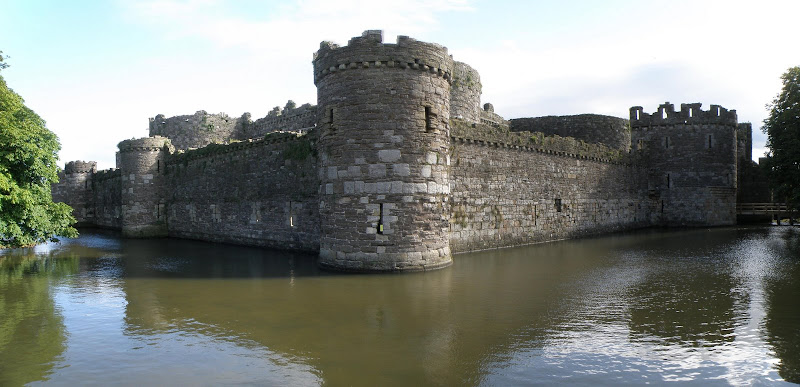
The classic moat around the castle provides a true medieval feel, the family of Swans makes it quaint, especially when they all get out and wander into the tourist shop.
As you drive along the Welsh roadways you never know what you are going to see, we think we have discovered another castle, it turns out that it's someone's house with castle like spires.
We have to make a stop in the uniquely named village that is most commonly known in Wales as Llanfair PG.... Llanfairpwllgwyngyllgogerychwyrndrobwilliantysiliogogogoch, the town name can be translated as "St Mary's church in the hollow of the white hazel near to the rapid whirlpool and the church of St Tysilio of the red cave". The long form of the name is the longest officially recognized place name in the United Kingdom and one of the longest in the world, being 58 letters in length. Originally known as Llanfair Pwllgwyngyll, it was given its long name in the 19th century in an attempt to develop the village as a commercial and tourist centre.
This train station sign is in thousands of photo albums
Caernarfon Castle was constructed at Caernarfon in north-west Wales, by King Edward I, following his conquest of Snowdonia in 1283. The majestic castle and it's walls dominate the city. It is a huge tourist attraction, but I guess we beat the crowds, and practically walk right in.
The history of the Prince of Wales was established here. According to a famous legend, the king had promised the Welsh that he would name "a prince born in Wales, who did not speak a word of English" and then produced his infant son to their surprise. Edward II was born at Caernarfon while his father was campaigning in Wales, and like all babies, could not at the time speak English.

By the time we leave the castle there is a huge line winding down the street, timing is everything
I guess. The aroma forces us to stop at a deli and grab some home-made lunch for the road.
The Four Alls pub... I pay for all (I take all)
On the way to our next stop we end up in a lot of traffic, first on an odd one lane toll road. Apparently a mining company makes a profit by letting people through their property. Then we are stuck in a traffic crawl through the town of Portmhadog, we never find out why, it's just slow.
Next up on the Castle tour is Criccieth Castle, as we arrive the rain is starting to really pick up. It's a short walk from the parking area through the quaint town and up the hill to the castle ruins.
Construction on Criccieth began in the early 13th century at the behest of Llywelyn ap Iorwerth of Gwynedd, and was later continued by his grandson Llywelyn ap Gruffydd, Prince of Wales. Because of its strategic location, it was a focal point in the war between England and Wales — eventually it was captured by Edward I of England during his second campaign in North Wales (1282-1283).
The castle was used as a prison until 1404, when the castle was captured by the then Prince of Wales in a revolt against England, the walls were torn down and the castle was set on fire.
The beach town looks nice, or maybe it would if it wasn't pouring rain so hard. The wind keeps blowing my umbrella inside out, so after a quick tour through the remains and towers of Criccieth it's time to head back to the car and continue our tour. The next stop would be a little different.
As we enter the resort area of Portmeirion we are fooled by a sign pointing to Castell Deudraeth, turns out it was just an 11 bedroom hotel and restaurant opened in 2001, but it looks like a castle.
Portmeirion is an Italian style resort village, it was designed and constructed between 1925 and 1975. Sir Clough Williams-Ellis, Portmeirion's designer wanted to pay tribute to the atmosphere of the Italian Mediterranean towns like Portofino. It's cute and cheesy at the same time.
Portmeirion has served as a location for films and television shows, shows such as 'Doctor Who', 'Danger Man' and most famously serving as The Village in 'The Prisoner' starring Patrick McGoohan.
Having had enough of the cheesiness of Portmeirion it was time to get back to some real history.
Our final castle in the 5 castle tour is Harlech Castle. Harlech was also built by King Edward I during his conquest of Wales. The castle was subject to several assaults and sieges during its time, including the seven-year siege of the castle, during the Wars of the Roses.
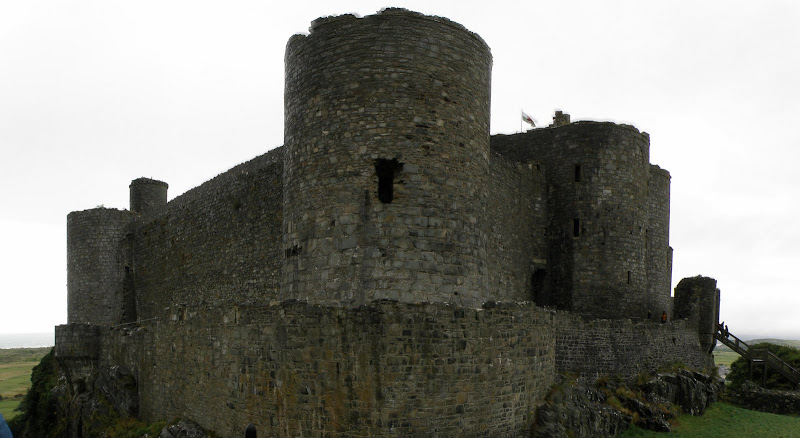
Lying in puddles inside of the castle remains are old cannonballs and boulders used for battle.
As we are leaving a group was setting up to do the play of Shakespeare's "Twelfth Night" in the castle grounds. It would be something to watch in this historic location, if it wasn't raining.
Our last stop on the way back to Conwy is the Snowdonia national park village of Beddgelert. The River Colwyn runs through the middle of town, it's quaint stone bridges and riverside houses make it a unique tourist town. The legend of the town name makes it even more so...
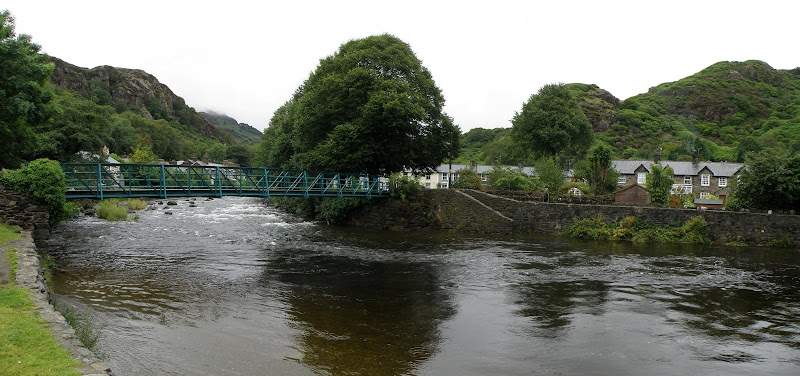
In the middle of a scenic field, nestled under a tree is a mound and gravestones telling the story.
GELERT'S GRAVE
In the 13th century, Llyweyn, Prince of North Wales, had a palace at Beddgelert. One day he went hunting without Gelert "the faithful hound" who was unaccountably absent. On Llwelyn's return, the truant stained and smeared with blood, joyfully sprang to meet his master. The prince alarmed hastened to find his son, and saw the infant's cot empty, the bedclothes and floor covered with blood. The frantic father plunged the sword into the hound's side thinking it had killed his heir. The dog's dying yell was answered by a child's cry. Llwelyn searched and discovered his boy unharmed but near by lay the body of a mighty wolf which Gelert had slain, the prince filled with remorse is said never to have smiled again. He buried Gelert here. The spot is called Beddgelert.
Although the story of Gellert's grave was most likely to have been created for tourism reasons, it makes quite a story. As we walk through the fields a historic steam train smokes by. Our last meal in Wales would be at a quaint pizza parlour in this quaint little village.
The lasting memory of Wales would be a sculpture of the Welsh Dragon... the dragon that appears on the flag of Wales. The flag is based on the legend of a battle between a red and white dragon, the white dragon representing the Saxons, the red dragon representing the people of Wales.
The Red Dragon won!
That night we watched a DVD called 'Once' from our B&B's large collection. A modern-day musical about a busker and an immigrant and their eventful week in Dublin, as they write, rehearse and record songs that tell their love story. A perfect setup for the next part of our journey.
After a very nice breakfast and a farewell to our hosts, we head outside to a sunny day. We drive to the coastal port of Holyhead, drop off the car after 2632 miles, and catch the Ferry to Ireland.


